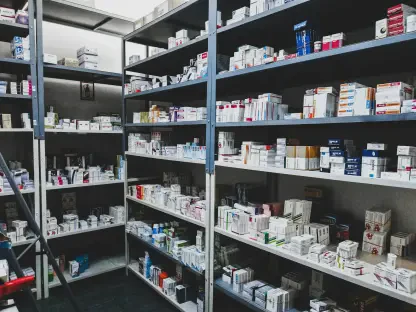The global surgical equipment market is on a significant growth trajectory, driven by advancements in surgical techniques, rising prevalence of chronic diseases, and ongoing technological innovations. This article delves into the key drivers, trends, and regional insights shaping the future of the surgical equipment market.
Key Drivers and Trends in the Surgical Equipment Market
Advancements in Surgical Techniques
One of the primary drivers of market growth is the significant advancements in surgical techniques. The development and increased adoption of minimally invasive surgery techniques have escalated the demand for specialized surgical equipment. These advancements allow for smaller incisions, which facilitate faster recovery times and reduce the risk of complications. This shift towards less invasive procedures is transforming the surgical landscape and propelling the market for innovative surgical tools.
The rise of robotic-assisted surgeries is another critical factor. Robotic systems provide surgeons with enhanced precision, flexibility, and control during operations. These systems are particularly beneficial in complex procedures, where traditional methods may fall short. The integration of robotics in surgery is revolutionizing the field, offering greater control and accuracy, which in turn drives the demand for advanced surgical equipment. Furthermore, robotic surgery reduces human error, thereby increasing the safety and success rates of surgeries. Surgeons can perform delicate and intricate operations that might be challenging with conventional techniques, ultimately expanding the market for sophisticated surgical tools.
Rising Prevalence of Chronic Diseases
The increasing prevalence of chronic diseases such as heart disease, cancer, and diabetes is another crucial factor contributing to the market expansion. The growing burden of these conditions has led to an increase in the number of surgical procedures conducted globally. As a result, the demand for advanced surgical equipment that can improve surgical outcomes and patient recovery times is on the rise.
Chronic diseases often require surgical interventions for treatment or management, further driving the need for specialized surgical tools. For instance, cardiovascular surgeries necessitate the use of high-precision instruments to ensure successful outcomes. The rising incidence of such diseases underscores the importance of continuous innovation in surgical equipment to meet the evolving needs of healthcare providers and patients. Moreover, as the population ages and lifestyles change, the burden of chronic illnesses is expected to rise, further boosting the demand for advanced surgical solutions. Hospitals and healthcare providers are increasingly focusing on upgrading their surgical departments with state-of-the-art equipment to address this growing need.
Technological Innovations
Technological innovations in the medical sector are also fueling the growth of the surgical equipment market. Innovations in robotics, imaging, and material sciences have led to the development of new and improved surgical equipment. These advancements enhance the precision of surgical procedures, minimize risks, and improve patient outcomes.
The introduction of 3D printing technology in the production of surgical tools is a notable example. 3D printed surgical instruments offer customization and precision that traditional manufacturing methods cannot match. This technology allows for the creation of patient-specific tools, improving the fit and functionality of surgical equipment. As 3D printing technology continues to evolve, its impact on the surgical equipment market is expected to grow. Additionally, advances in laser technology and smart sensors are contributing to the development of more precise and effective surgical devices. These innovations are not only transforming the surgical landscape but also opening up new possibilities for the future of medical procedures.
Regional Insights
North America Leading the Market
North America held the largest share of the surgical equipment market in 2023, accounting for 41% of the market. The region’s dominance is attributed to several factors, including the high number of surgical procedures performed annually, advancements in healthcare infrastructure, and the presence of leading industry players. For instance, the United States alone conducts around 40 to 50 million surgeries annually, making it a significant contributor to the market.
Technological innovations and favorable government policies in North America are also propelling market growth. For example, in May 2023, Crothall Healthcare partnered with Ascendco Health to introduce advanced tracking systems for sterile surgical instruments in U.S. healthcare facilities. This partnership underscores the emphasis on safety, quality, and technological improvement in the region’s healthcare system. The emphasis on cutting-edge healthcare solutions ensures that North America remains at the forefront of the surgical equipment landscape. Furthermore, the presence of a highly skilled medical workforce and substantial investment in research and development are additional factors driving market growth in the region.
Asia Pacific Emerging as the Fastest Growing Market
Asia Pacific is expected to grow at the fastest rate in the coming years, driven by a combination of factors such as a rising geriatric population, increasing surgical procedures, and rapid healthcare infrastructure development. In India, for instance, approximately 30 million surgical procedures are performed annually. The country has also attracted significant foreign direct investments in medical and surgical appliances, amounting to over USD 3.28 billion from April 2000 to March 2024.
Countries like China, South Korea, and Japan are global leaders in plastic surgeries, ranking third, fourth, and fifth respectively. This highlights the growing acceptance and demand for surgical procedures in the region. Further bolstering market growth, government policies are being implemented to enhance healthcare infrastructure. For instance, in 2022, the Chinese government introduced a USD 29 billion loan incentive policy to upgrade medical facilities, boosting demand for advanced surgical tools. The region’s commitment to improving healthcare accessibility and quality, along with the rising middle-class population, is creating substantial opportunities for market expansion.
Related Markets Impacted by Surgical Equipment
3D Printed Medical Devices Market
The 3D printed medical devices market is expected to gain momentum in the upcoming years, driven by advancements in surgical tools. These devices, which range from imaging equipment like MRI machines to monitoring devices and implants, improve patient outcomes through precise customization. Custom devices like hearing aids, orthotics, and surgical tools designed with exact measurements offer superior fit and comfort over mass-produced alternatives.
The ability to produce patient-specific instruments and implants is revolutionizing the medical field. Surgeons can now use 3D printed models to plan complex surgeries, reducing the risk of errors and improving surgical outcomes. As the technology advances, the integration of 3D printing in surgical equipment is expected to become more widespread, enhancing the capabilities of healthcare professionals. The flexibility and adaptability of 3D printing also allow for rapid prototyping and innovation, ensuring that surgical equipment keeps pace with the latest advancements in medical science.
Medical Device Gaskets & Seals Market
The medical device gaskets & seals market, valued at USD 0.92 billion in 2023, is projected to grow to USD 1.57 billion by 2034, rising at a CAGR of 5%. The demand for high-quality, reliable components in medical devices has surged due to the expansion of the surgical equipment market, driven by technological advancements, an increase in surgical procedures, and stringent regulatory standards.
Gaskets and seals are critical components that ensure the proper functioning of medical devices by preventing leaks and maintaining sterility. The increasing complexity of surgical equipment and the need for precise performance are driving the demand for advanced gasket and seal solutions. Manufacturers are focusing on developing products that meet the rigorous quality standards of the medical industry while enhancing the durability and efficiency of surgical instruments. This market’s growth is closely tied to the innovations and advancements occurring within the broader surgical equipment landscape.
Conclusion
The global surgical equipment market is experiencing significant growth due to several key factors. Advances in surgical techniques, the rising prevalence of chronic diseases, and ongoing technological innovations are major contributors to this upward trajectory. These changes are revolutionizing how surgeries are performed, making them more efficient and effective.
One of the primary drivers of this market surge is the development and improvement of minimally invasive surgical procedures. These techniques reduce recovery times and minimize the risks associated with traditional surgeries, making them increasingly popular among patients and healthcare providers alike. Additionally, the surge in chronic diseases such as diabetes, cancer, and cardiovascular conditions has spurred the demand for surgical interventions.
Technological advancements also play a crucial role in this market’s expansion. Innovations in surgical robotics, imaging technologies, and smart surgical instruments are enhancing the precision and outcomes of various procedures. These tools not only improve patient safety but also streamline the workflow for surgeons, leading to better overall efficiency in the operating room.
Regional insights reveal that North America holds a significant share of the market due to its advanced healthcare infrastructure and higher adoption rate of cutting-edge technologies. Meanwhile, emerging economies in Asia-Pacific are witnessing rapid market growth, driven by increasing healthcare investments and greater access to medical facilities.
In summary, the global surgical equipment market’s growth is propelled by advancements in surgical techniques, the rising prevalence of chronic illnesses, and continuous technological innovations. These factors collectively shape the future of surgery, promising better patient outcomes and more streamlined healthcare processes across various regions.









